Categorization of Residential Appliances Using ZIP Load Modeling and Conservation Voltage Reduction Analysis
Abstract
1. Introduction
2. Literature Review
3. Methodology
3.1. Overview
3.2. Data Collection/Experimental Scenario
3.3. ZIP Load Model Analysis
3.4. CVR Analysis
3.5. Bottom-Up Load Model Analysis
- i.
- Both Singapore and Malaysia share similar physical and meteorological characteristics, as well as a tropical climate and comparable ethnic communities and demographic structures.
- ii.
- In Singapore and Malaysia, household electrical appliance models and power usage are similar.
- iii.
- Malaysia has a similar grid utility infrastructure, the same voltage level and uses the same type of sockets: both are 400/230 V for household electricity.
- iv.
- Both Singapore and Malaysia are in the same time zone and adjacent to each other.
4. Results and Discussion
4.1. Measurement Results
4.2. ZIP Load Model
4.3. CVR Factor
4.4. Load Categorization
4.5. Bottom-Up Load Model
5. Conclusions
Author Contributions
Funding
Data Availability Statement
Conflicts of Interest
References
- Bircan, M.; Durusu, A.; Kekezoglu, B.; Elma, O.; Selamogullari, U.S. Determination of zip coefficients for residential loads. Pressacademia 2017, 5, 176–180. [Google Scholar] [CrossRef]
- Seva, M.; Abdullah, K.; Busrah, I.A.M.; Zin, N.D.R.M.; Balasubramaniam, I.Y.; Daud, M.H.M.; Pauzai, N.S.B. Analysis of Conservation Voltage Reduction (Cvr) Factor for Various Types of Loads. Int. J. Eng. Appl. Sci. Technol. 2020, 5, 66–72. [Google Scholar] [CrossRef]
- Yadav, G.; Liao, Y.; Jewell, N.; Ionel, D.M. CVR Study and Active Power Loss Estimation Based on Analytical and ANN Method. Energies 2022, 15, 4689. [Google Scholar] [CrossRef]
- Ma, Z.; Xiang, Y.; Wang, Z. Robust Conservation Voltage Reduction Evaluation Using Soft Constrained Gradient Analysis. IEEE Trans. Power Syst. 2022, 37, 4485–4496. [Google Scholar] [CrossRef]
- Bircan, M.; Durusu, A.; Kekezoglu, B.; Elma, O.; Selamogullari, U.S. Experimental determination of ZIP coefficients for residential appliances and ZIP model based appliance identification: The case of YTU Smart Home. Electr. Power Syst. Res. 2020, 179, 106070. [Google Scholar] [CrossRef]
- Chuan, L.; Rao, D.M.K.K.V.; Ukil, A. Load profiling of Singapore buildings for peak shaving. In Proceedings of the Asia-Pacific Power and Energy Engineering Conference (APPEEC), Hong Kong, China, 7–10 December 2014. [Google Scholar] [CrossRef]
- Zhang, Q.; Guo, Y.; Wang, Z.; Bu, F. Distributed Optimal Conservation Voltage Reduction in Integrated Primary-Secondary Distribution Systems. IEEE Trans. Smart Grid 2021, 12, 3889–3900. [Google Scholar] [CrossRef]
- Ozdemir, G.; Baran, M. A new method for Volt–Var optimization with conservation voltage reduction on distribution systems. Electr. Eng. 2020, 102, 493–502. [Google Scholar] [CrossRef]
- Sundaram, M.S.B.; Tan, C.; Selvaraj, J.; Abu Bakar, A.H. Energy Savings for Various Residential Appliances and Distribution Networks in a Malaysian Scenario. Energies 2023, 13, 4902. [Google Scholar] [CrossRef]
- Stanescu, D.; Enache, F.; Popescu, F. Smart Non-Intrusive Appliance Load-Monitoring System Based on Phase Diagram Analysis. Smart Cities 2024, 7, 1936–1949. [Google Scholar] [CrossRef]
- Chabane, L.; Drid, S.; Chrifi-Alaoui, L.; Delahoche, L. Energy consumption prediction of a smart home using non-intrusive appliance load monitoring. Int. J. Syst. Assur. Eng. Manag. 2023, 15, 1231–1244. [Google Scholar] [CrossRef]
- Faustine, A.; Pereira, L. Improved appliance classification in non-intrusive load monitoring using weighted recurrence graph and convolutional neural networks. Energies 2020, 13, 3374. [Google Scholar] [CrossRef]
- Ghosh, S.; Panda, D.K.; Das, S.; Chatterjee, D. Cross-Correlation Based Classification of Electrical Appliances for Non-Intrusive Load Monitoring. In Proceedings of the 2021 International Conference on Sustainable Energy and Future Electric Transportation, SeFet 2021, Hyderabad, India, 21–23 January 2021. [Google Scholar] [CrossRef]
- Arif, A.; Wang, Z.; Wang, J.; Mather, B.; Bashualdo, H.; Zhao, D. Load Modeling—A Review. IEEE Trans. Smart Grid 2017, 9, 5986–5999. [Google Scholar] [CrossRef]
- Goldin, A.; Buechler, E.; Rajagopal, R.; Rivas-Davila, J. Time and voltage domain load models for appliance-level grid edge simulation and control. Electr. Power Syst. Res. 2021, 190, 106750. [Google Scholar] [CrossRef]
- Hasan, M.K.; Ahmed, M.M.; Wani, N.F.; Abbas, A.H.; Alkwai, L.M.; Islam, S.; Habib, A.A.; Hassan, R. Dynamic load modeling for bulk load-using synchrophasors with wide area measurement system for smart grid real-time load monitoring and optimization. Sustain. Energy Technol. Assess. 2023, 57, 103190. [Google Scholar] [CrossRef]
- Nourollahi, R.; Salyani, P.; Zare, K.; Mohammadi-Ivatloo, B.; Abdul-Malek, Z. Peak-Load Management of Distribution Network Using Conservation Voltage Reduction and Dynamic Thermal Rating. Sustainability 2022, 14, 11569. [Google Scholar] [CrossRef]
- Behzadirafi, S.; Malallah, Y.; Qaseer, L.; de León, F. Theoretical and Experimental Verification of CVR Energy Savings for Refrigeration Loads. IEEE Trans. Power Deliv. 2023, 38, 2489–2499. [Google Scholar] [CrossRef]
- Hossein, Z.S.; Khodaei, A.; Fan, W.; Hossan, S.; Zheng, H.; Fard, S.A.; Paaso, A.; Bahramirad, S. Conservation voltage reduction and Volt-VAR optimization: Measurement and verification benchmarking. IEEE Access 2020, 8, 50755–50770. [Google Scholar] [CrossRef]
- Shim, K.-S.; Go, S.-I.; Yun, S.-Y.; Choi, J.-H.; Nam-Koong, W.; Shin, C.-H.; Ahn, S.-J. Estimation of conservation voltage reduction factors using measurement data of KEPCO system. Energies 2017, 10, 2148. [Google Scholar] [CrossRef]
- Bokhari, A.; Raza, A.; Diaz-Aguilo, M.; de Leon, F.; Czarkowski, D.; Uosef, R.E.; Wang, D. Combined Effect of CVR and DG Penetration in the Voltage Profile of Low-Voltage Secondary Distribution Networks. IEEE Trans. Power Deliv. 2016, 31, 286–293. [Google Scholar] [CrossRef]
- Wang, S.; Deng, X.; Chen, H.; Shi, Q.; Xu, D. A bottom-up short-term residential load forecasting approach based on appliance characteristic analysis and multi-task learning. Electr. Power Syst. Res. 2021, 196, 107233. [Google Scholar] [CrossRef]
- Gao, B.; Liu, X.; Zhu, Z. A bottom-up model for household load profile based on the consumption behavior of residents. Energies 2018, 11, 2112. [Google Scholar] [CrossRef]
- Tsuji, K.; Sano, F.; Ueno, T.; Saeki, O. Bottom-Up Simulation Model for Estimating End-Use Energy Demand Profiles in Residential Houses Development of the Bottom-Up Simulation Model. ACEEE Summer Study Energy Effic. Build. 2004, 2, 342–355. [Google Scholar]
- Bugaje, B.; Rutherford, P.; Clifford, M. A systems dynamics approach to the bottom-up simulation of residential appliance load. Energy Build. 2021, 247, 111164. [Google Scholar] [CrossRef]
- Parker, A.; Alkrch, M.A.; James, K.; Almaghrebi, A.; Alahmad, M.A. Framework to Develop Time- and Voltage-Dependent Building Load Profiles Using Polynomial Load Models. IEEE Access 2021, 9, 128328–128344. [Google Scholar] [CrossRef]
- El-Shahat, A.; Haddad, R.J.; Alba-Flores, R.; Rios, F.; Helton, Z. Conservation voltage reduction case study. IEEE Access 2020, 8, 55383–55397. [Google Scholar] [CrossRef]
- Jierula, A.; Wang, S.; Oh, T.-M.; Wang, P. Study on accuracy metrics for evaluating the predictions of damage locations in deep piles using artificial neural networks with acoustic emission data. Appl. Sci. 2021, 11, 2314. [Google Scholar] [CrossRef]
- Chuan, L.; Ukil, A. Modeling and Validation of Electrical Load Profiling in Residential Buildings in Singapore. IEEE Trans. Power Syst. 2015, 30, 2800–2809. [Google Scholar] [CrossRef]
- Shen, Y. Assessment of Conservation Voltage Reduction on HV and LV Distribution Networks. Ph.D. Thesis, The University of Manchester, Manchester, UK, 2018. [Google Scholar]
- Bokhari, A.; Alkan, A.; Dogan, R.; Diaz-Aguilo, M.; De Leon, F.; Czarkowski, D.; Zabar, Z.; Birenbaum, L.; Noel, A.; Uosef, R.E. Experimental determination of the ZIP coefficients for modern residential, commercial, and industrial loads. IEEE Trans. Power Deliv. 2014, 29, 1372–1381. [Google Scholar] [CrossRef]
- Jereminov, M.; Hooi, B.; Pandey, A.; Song, H.-A.; Faloutsos, C.; Pileggi, L. Impact of Load Models on Power Flow Optimization. In Proceedings of the 2019 IEEE Power & Energy Society General Meeting (PESGM), Atlanta, GA, USA, 4–8 August 2019; pp. 1–5. [Google Scholar]
- Tenaga National Sustainability Report. Energy To Sustain Communities. 2018, pp. 1–108. Available online: www.tnb.com.my (accessed on 20 January 2020).
- Wang, Z.; Wang, J. Review on implementation and assessment of conservation voltage reduction. IEEE Trans. Power Syst. 2014, 29, 1306–1315. [Google Scholar] [CrossRef]
- Sen, P.K.; Lee, K.H. Conservation Voltage Reduction Technique: An Application Guideline for Smarter Grid. IEEE Trans. Ind. Appl. 2016, 52, 2122–2128. [Google Scholar] [CrossRef]
- Lefebvre, S.; Gaba, G.; Ba, A.-O.; Asber, D.; Ricard, A.; Perreault, C.; Chartrand, D. Measuring the efficiency of voltage reduction at Hydro-Québec distribution. In Proceedings of the 2008 IEEE Power and Energy Society General Meeting—Conversion and Delivery of Electrical Energy in the 21st Century, Pittsburgh, PA, USA, 20–24 July 2008; pp. 1–7. [Google Scholar] [CrossRef]
- Williams, B. Distribution capacitor automation provides integrated control of customer voltage levels and distribution reactive power flow. In Proceedings of the Power Industry Computer Applications Conference, Salt Lake City, UT, USA, 7–12 May 1995; pp. 215–220. [Google Scholar] [CrossRef]
- Sasidharan, N.; Madhu, M.N.; Singh, J.G.; Ongsakul, W. An approach for an efficient hybrid AC/DC solar powered Homegrid system based on the load characteristics of home appliances. Energy Build. 2015, 108, 23–35. [Google Scholar] [CrossRef]
- Pacific Northwest National Laboratory and PNNL. Evaluation of CVR on a National Level. Report. 2010. Available online: http://www.pnl.gov/main/publications/external/technical_reports/PNNL-19596.pdf (accessed on 30 November 2021).
- Selamogullari, U.S.; Alsaad, A. Analysis of a Residential Distribution System with the Application of Conservation Voltage Reduction at House Level. In Proceedings of the 2019 1st Global Power, Energy and Communication Conference (GPECOM), Nevsehir, Turkey, 12–15 June 2019; pp. 430–434. [Google Scholar] [CrossRef]
- Tellez, A.P. Modelling Aggregate Loads in Power Systems. Master’s Thesis, KTH Royal Institute of Technology School of Electrical Engineering, Stockholm, Sweden, 2017. [Google Scholar]

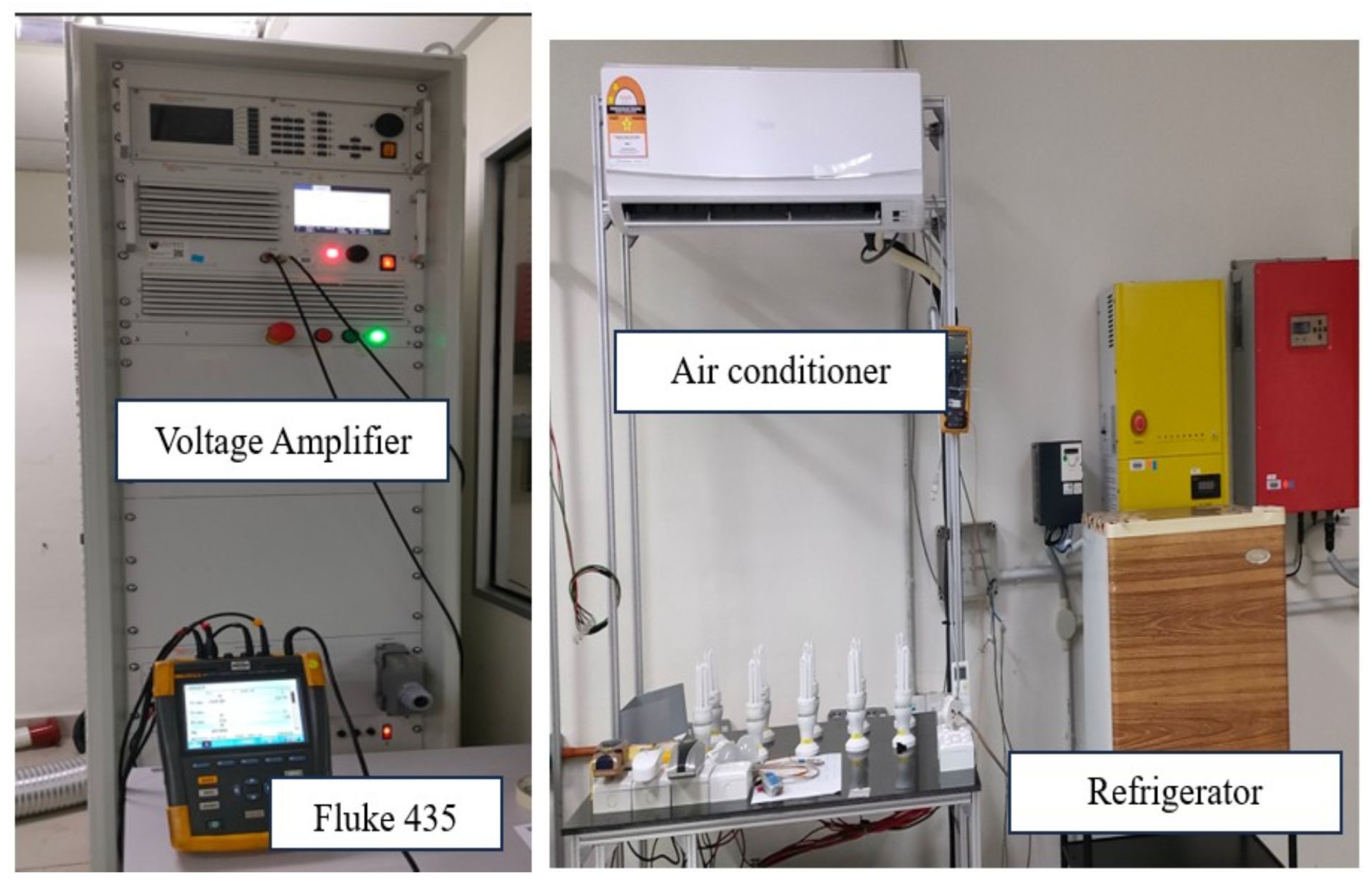

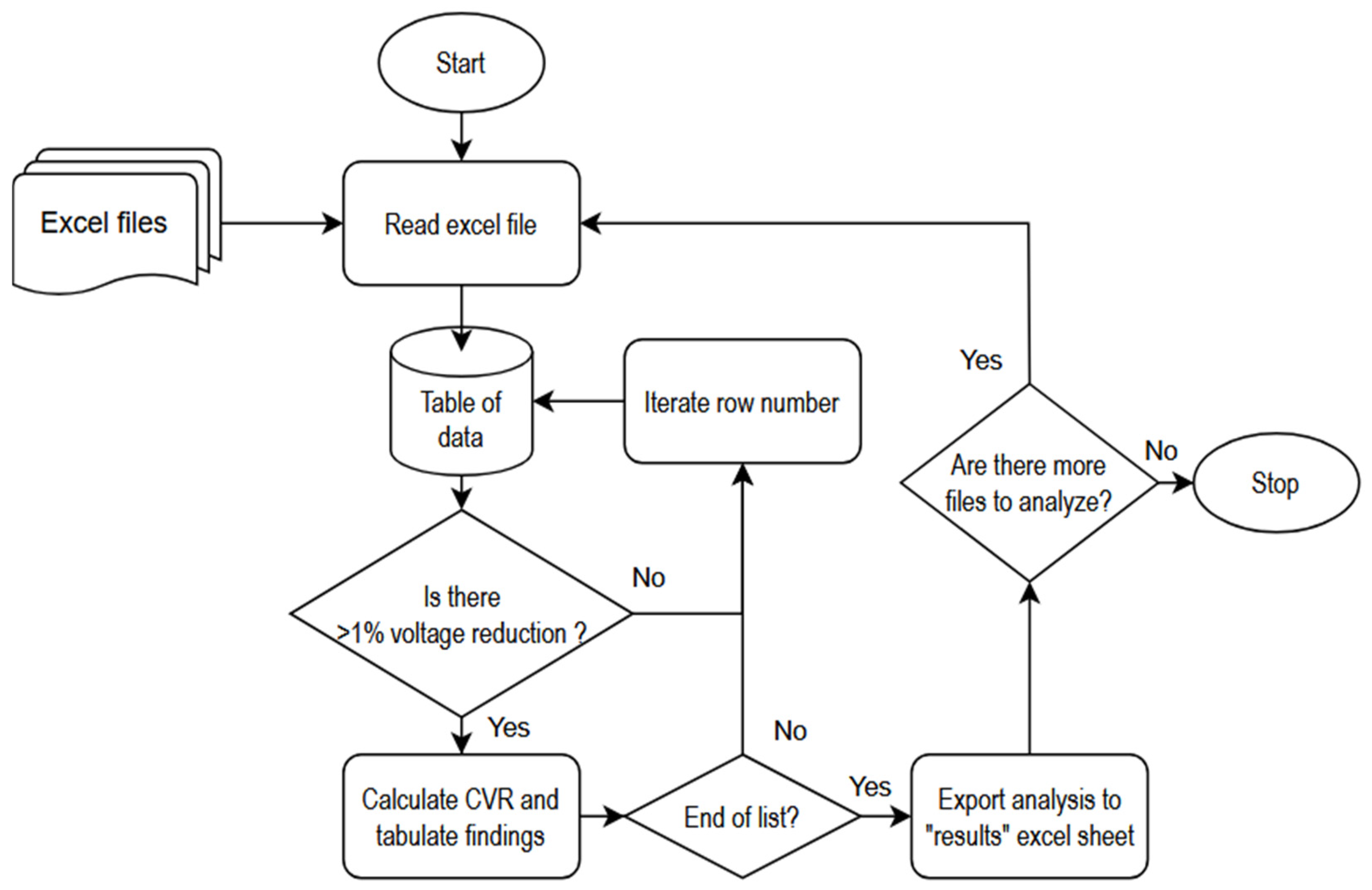
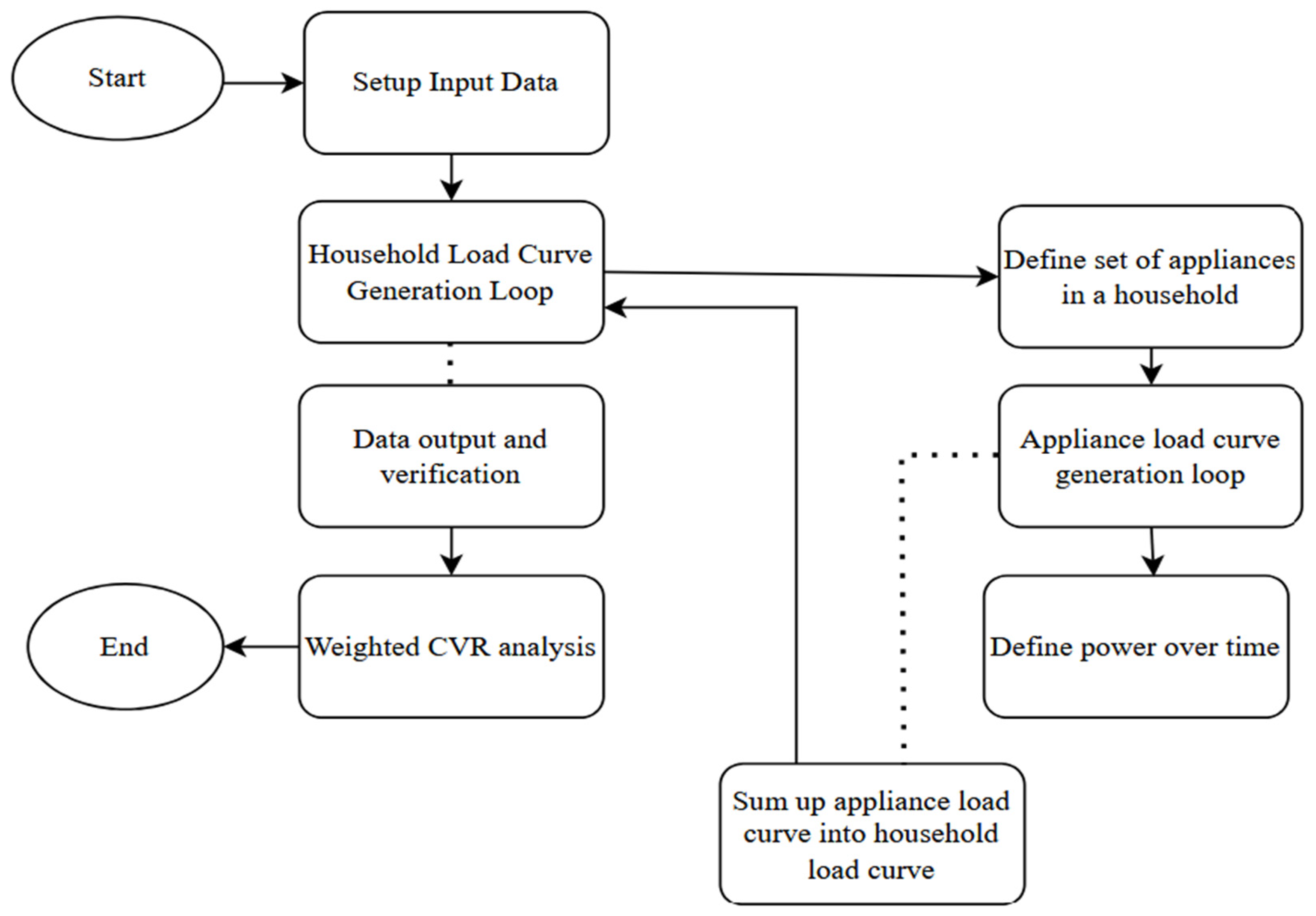

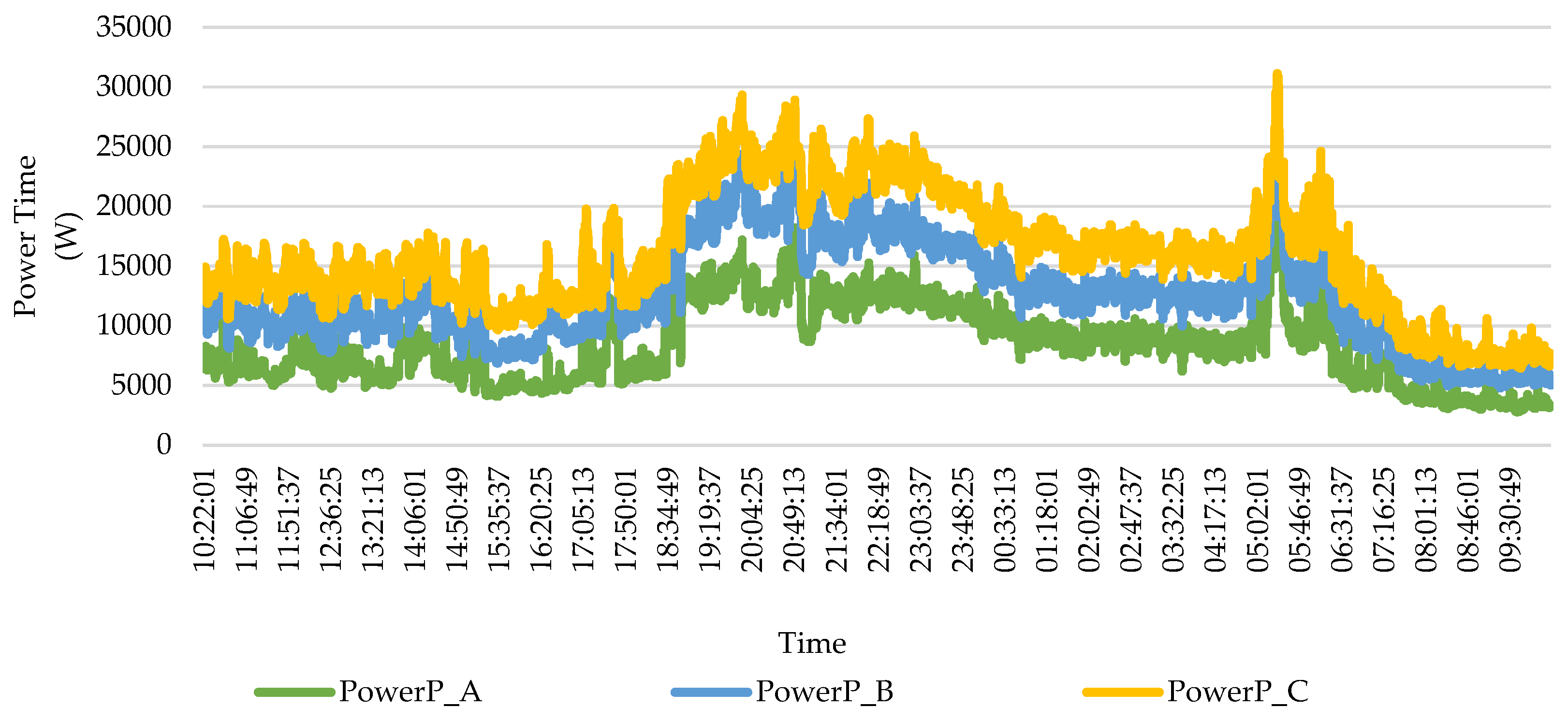

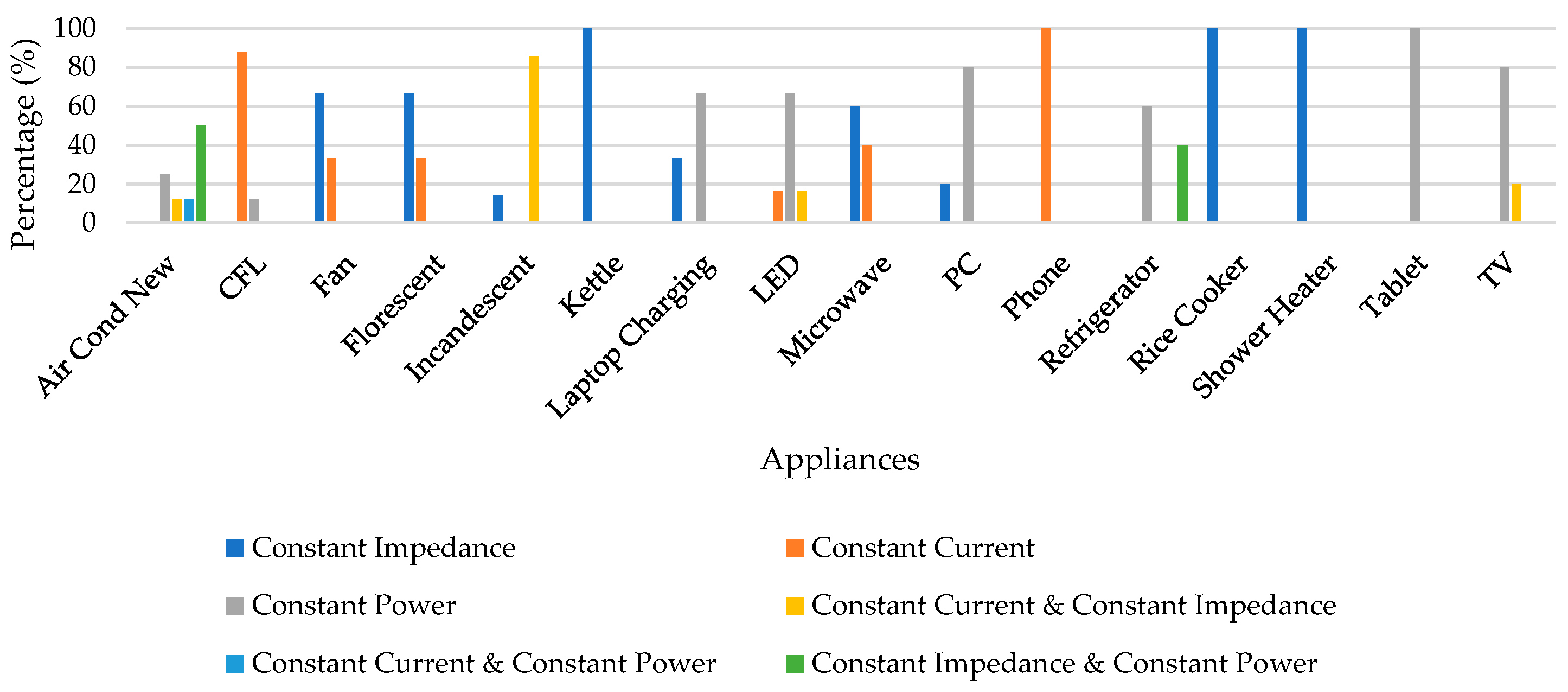
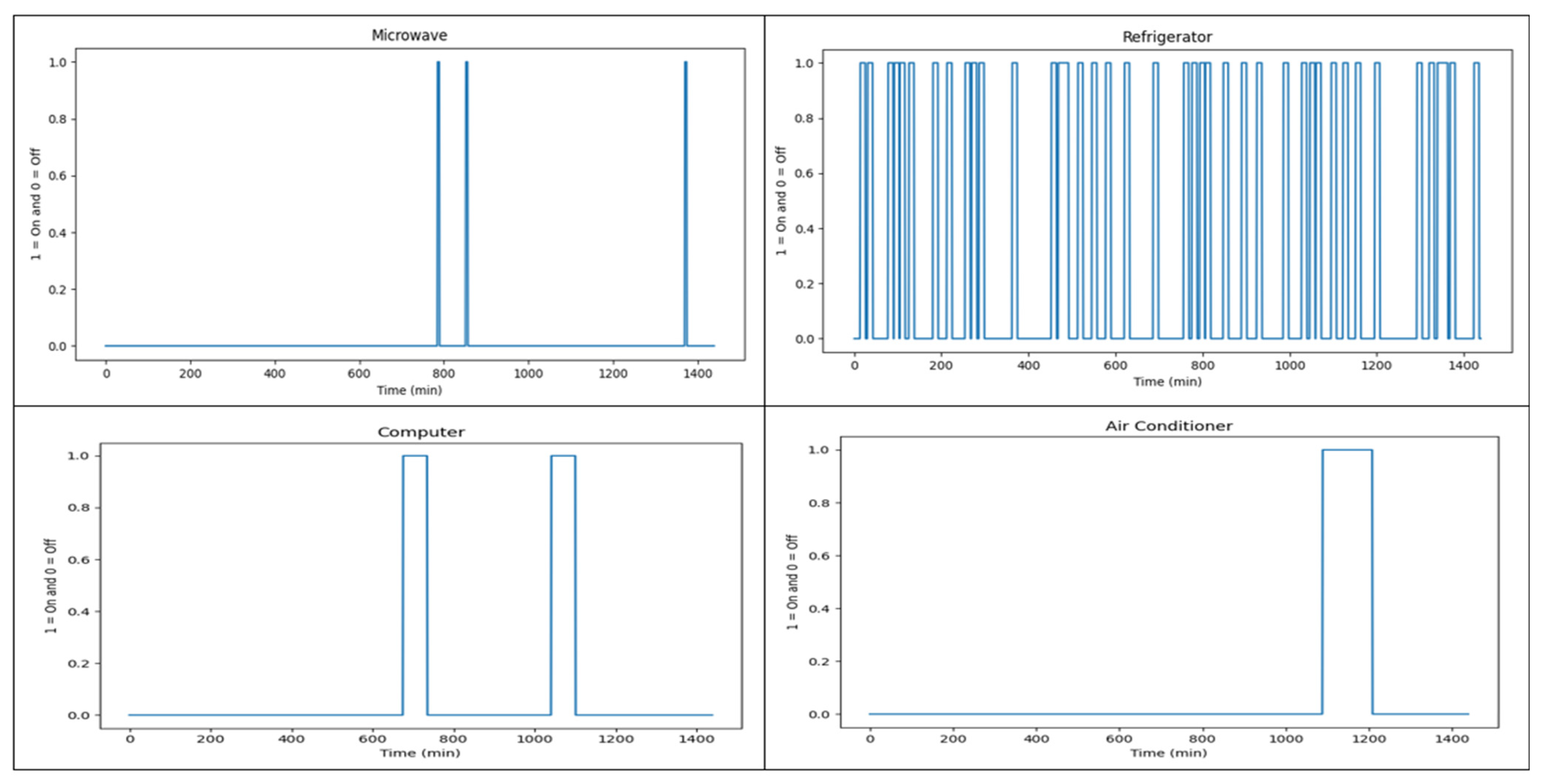

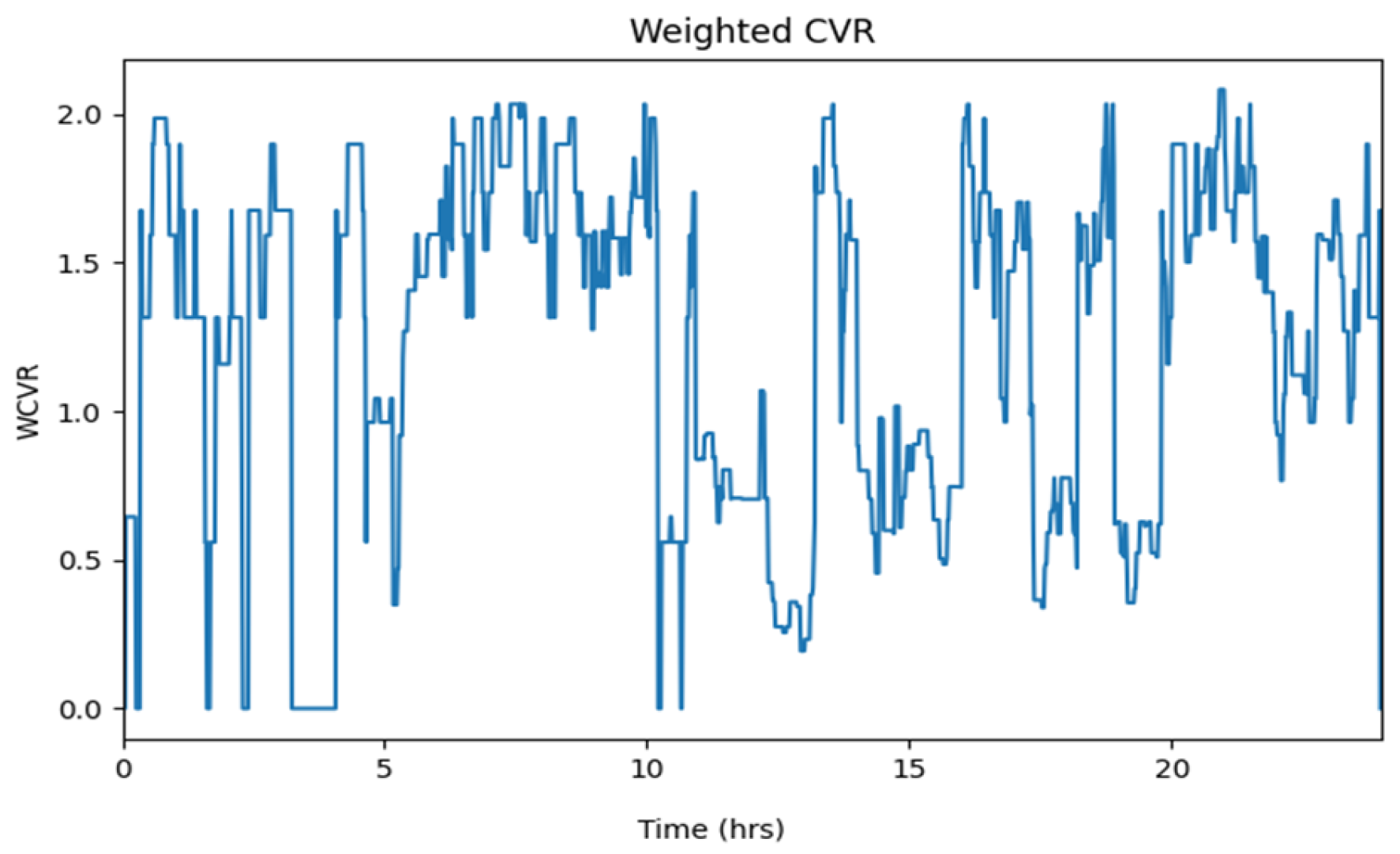
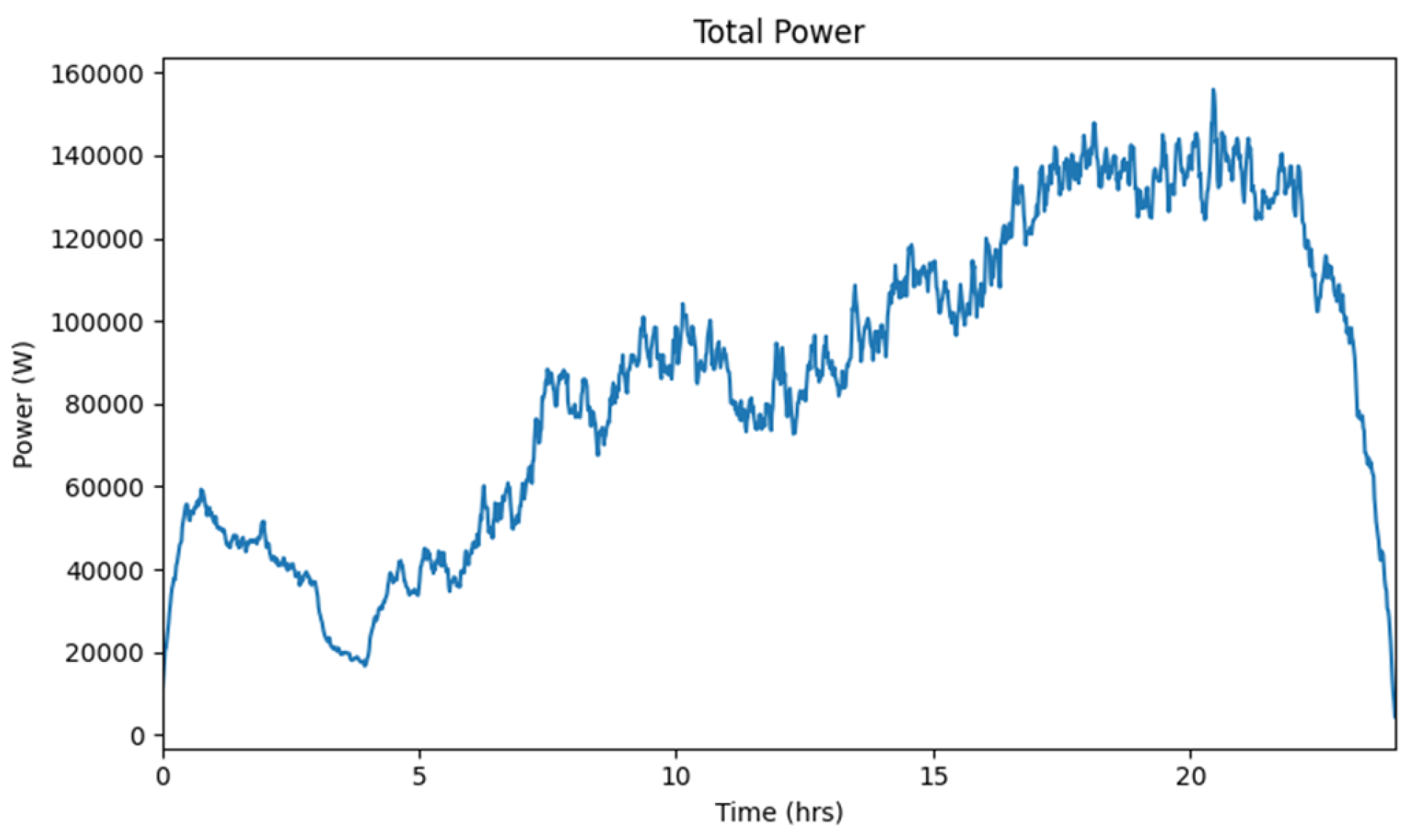

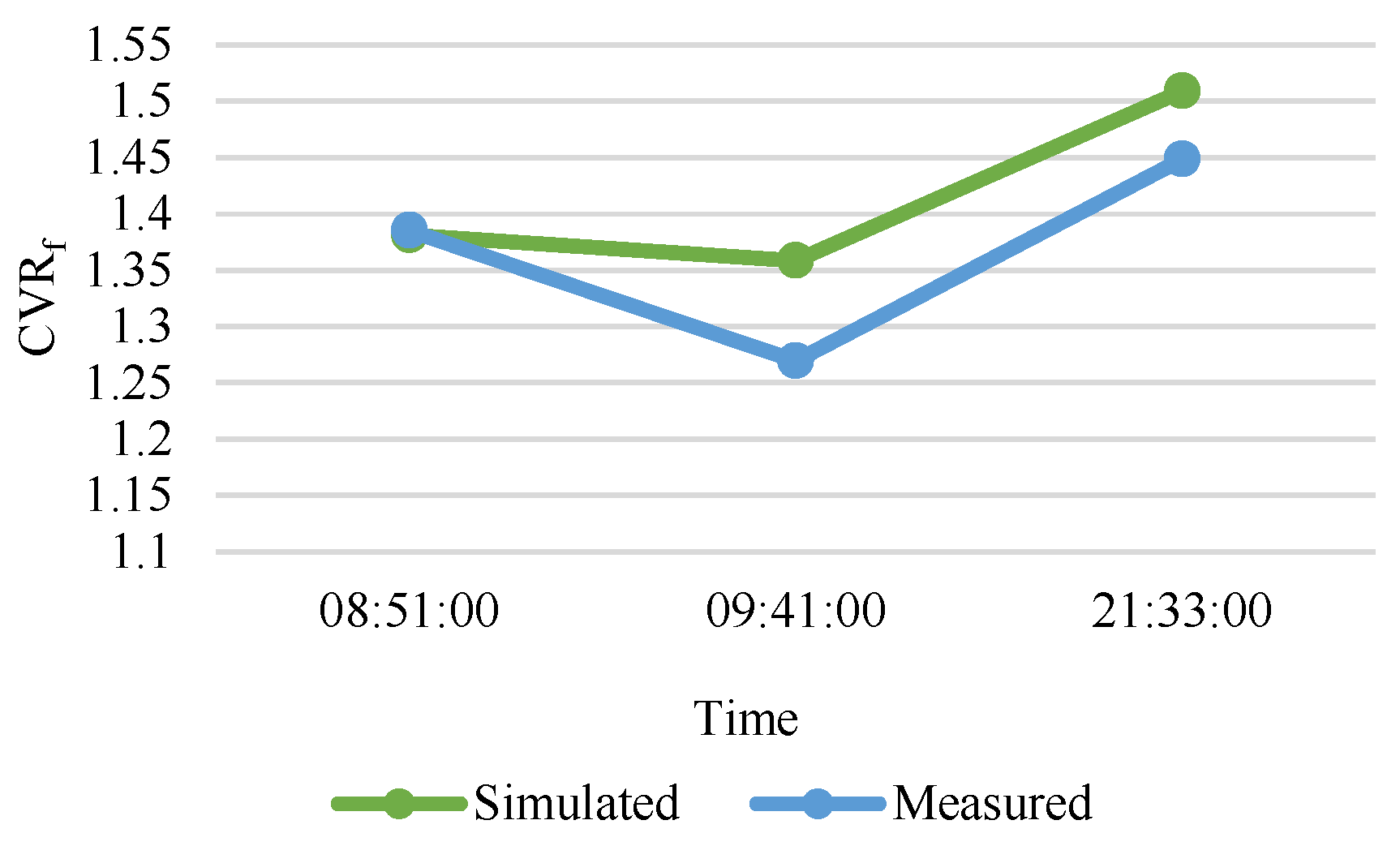
| Appliance | Z | I | P | MAE | MAPE |
|---|---|---|---|---|---|
| Air Conditioner | 1.57417 × 10−19 | 0.503564049 | 0.496435951 | 9.194761207 | 0.875672345 |
| CFL | 0.209873 | 0.536 | 0.254126 | 0.060968 | 0.52456 |
| Fan | 0.946820139 | 9.6932 × 10−17 | 0.053179861 | 0.086495025 | 0.221996809 |
| Florescent | 1 | 1.09609 × 10−19 | 0 | 0.451774313 | 1.449853662 |
| TV | 0.03196 | 4.70868 × 10−19 | 0.968 | 0.380759 | 0.51101 |
| Incandescent | 0.517501382 | 0.482498618 | 1.66783 × 10−19 | 0.043556181 | 0.047191287 |
| Kettle | 1 | 0 | 4.25743 × 10−13 | 0.507451166 | 0.047350111 |
| Laptop Charging | 5.28333 × 10−22 | 0.237052477 | 0.762947523 | 2.691676867 | 6.646028282 |
| LED | 0.065558618 | 1.89856 × 10−12 | 0.934441382 | 0.040012265 | 0.424632462 |
| Microwave | 1 | 4.16941 × 10−13 | 2.18613 × 10−12 | 107.4012509 | 9.345332794 |
| PC | 0.031629634 | 8.62397 × 10−15 | 0.968370366 | 3.502793751 | 2.776485452 |
| Phone | 8.96913 × 10−18 | 0.702989911 | 0.297010089 | 0.121677919 | 1.116739011 |
| Refrigerator | 0 | 0 | 1 | 8.326586 | 7.925898 |
| Rice Cooker | 0.828714131 | 0.171285869 | 6.4405 × 10−12 | 2.404325872 | 0.444402796 |
| Shower Heater | 1 | 0 | 6.497 × 10−18 | 48.57101173 | 1.954857176 |
| Tablet | 8.4538 × 10−13 | 0.088605655 | 0.911394345 | 0.018055442 | 0.161206113 |
| Appliance | CVR Index (P) |
|---|---|
| Air conditioner | 0.499 |
| CFL light | 1.308 |
| Fluorescent light | 2.189 |
| Incandescent light | 1.526 |
| LED light | 0.313 |
| Kettle | 1.992 |
| Fan | 1.889 |
| Laptop | 0.454 |
| PC | 0.116 |
| Phone | 0.777 |
| Tablet | 0.095 |
| TV | 0.058 |
| Microwave | 1.479 |
| Rice cooker | 1.942 |
| Shower heater | 2.440 |
| Refrigerator | 0.705 |
| Appliance | Appliance Type Based on CVR Values | Appliance Type Based on ZIP Values |
|---|---|---|
| Air conditioner | Constant Power | Constant Power and Current |
| CFL light | Constant Current | Constant Current |
| Fluorescent light | Constant Impedance | Constant Impedance |
| Incandescent light | Constant Current | Constant Impedance and Current |
| LED light | Constant Power | Constant Power |
| Fan | Constant Impedance | Constant Impedance |
| Laptop (charging) | Constant Power | Constant Power |
| Kettle | Constant Impedance | Constant Impedance |
| PC | Constant Power | Constant Power |
| Phone | Constant Power | Constant Current |
| Tablet | Constant Power | Constant Power |
| TV (new) | Constant Power | Constant Power |
| Microwave | Constant Current | Constant Impedance |
| Rice cooker | Constant Impedance | Constant Impedance |
| Shower heater | Constant Impedance | Constant Impedance |
| Refrigerator | Constant Power | Constant Power |
| ZIP Values from Published Papers | Air Conditioner | CFL | Fan | Florescent | Incandescent | Kettle | Laptop Charging | LED | Microwave | PC | Phone | Refrigerator | Rice Cooker | Shower Heater | Tablet | TV |
|---|---|---|---|---|---|---|---|---|---|---|---|---|---|---|---|---|
| [31] | Zp = 1.6 | Zp = −0.63 | Zp = 0.26 | Zp = 0.54 | Zp = 0.25 | Zp = 0.69 | Zp = −0.27 | Zp = 0.18 | Zp = 5.03 | Zp = 0.33 | ||||||
| Ip = −2.69 | Ip = 1.66 | Ip = 0.9 | Ip = 0.5 | Ip = −0.48 | Ip = 0.92 | Ip = 1.16 | Ip = −0.26 | Ip = −8.48 | Ip = −0.57 | |||||||
| Pp = 2.09 | Pp = −0.03 | Pp = −0.16 | Pp = −0.04 | Pp = 1.23 | Pp = −0.61 | Pp = 0.11 | Pp = 1.08 | Pp = 4.45 | Pp = 1.24 | |||||||
| Constant Impedance and Constant Power | Constant Current | Constant Current | Constant Impedance and Constant Current | Constant Power | Constant Impedance and Constant Current | Constant Current | Constant Power | Constant Impedance and Constant Power | Constant Power | |||||||
| [1] | Zp = 0.11 | Zp = 0.49 | Zp = 0.95 | Zp = 0.73 | ||||||||||||
| Ip = 0.64 | Ip = 0.59 | Ip = 0.07 | Ip = −1.70 | |||||||||||||
| Pp = 0.25 | Pp = −0.08 | Pp = −0.02 | Pp = 1.97 | |||||||||||||
| Constant Current | Constant Current & Constant Impedance | Constant Impedance | Constant Power | |||||||||||||
| [5] | Zp = 1.55 | Zp = 0.11 | Zp = 2.74 | Zp = 0.49 | Zp = 0.95 | Zp = 0.73 | Zp = 1 | Zp = 0.48 | Zp = 1.04 | Zp = −0.4 | ||||||
| Ip = −2.12 | Ip = 0.64 | Ip = −2.64 | Ip = 0.59 | Ip = 0.07 | Ip = −1.7 | Ip = 0.6 | Ip = −0.64 | Ip = −1.57 | Ip = 0.45 | |||||||
| Pp = 1.57 | Pp = 0.25 | Pp = 0.09 | Pp = −0.08 | Pp = −0.02 | Pp = 1.97 | Pp = −0.6 | Pp = 1.16 | Pp = 1.53 | Pp = 0.95 | |||||||
| Constant Power and Constant Impedance | Constant Current | Constant Impedance | Constant Current and Constant Impedance | Constant Impedance | Constant Power | Constant Impedance | Constant Power | Constant Power | Constant Power | |||||||
| [38] | Zp = 0.442 | Zp = −0.887 | Zp = 0.583 | Zp = 2.037 | Zp = 0.796 | Zp = 0.895 | Zp = −0.553 | Zp = 1.516 | Zp = 1.425 | Zp = 0.758 | Zp = 1.883 | Zp = 0.571 | ||||
| Ip = 0.442 | Ip = 2.145 | Ip = 1.277 | Ip = −0.795 | Ip = 0.406 | Ip = 0.051 | Ip = 0.500 | Ip = 0.499 | Ip = 0.799 | Ip = −0.297 | Ip = 1.331 | Ip = 0.484 | |||||
| Pp = 0.116 | Pp = −0.258 | Pp = −0.860 | Pp = −0.242 | Pp = −0.202 | Pp = 0.055 | Pp = 1.053 | Pp = −1.015 | Pp = −1.224 | Pp = 0.539 | Pp = −2.214 | Pp = −0.055 | |||||
| Constant Current and Constant Impedance | Constant Current | Constant Current | Constant Impedance | Constant Impedance | Constant Impedance | Constant Power | Constant Impedance | Constant Impedance | Constant Power and Constant Impedance | Constant Impedance | Constant Current and Constant Impedance | |||||
| [39] | Zp = −1.05% | Zp = 73.32% | Zp = 57.11% | Zp = −3.83% | ||||||||||||
| Ip = 100% | Ip = 25.34% | Ip = 42.57% | Ip = 3.96% | |||||||||||||
| Pp = 1.05% | Pp = 1.35% | Pp = 0.32% | Pp = 99.87% | |||||||||||||
| Constant Current | Constant Impedance | Constant Current and Constant Impedance | Constant Power | |||||||||||||
| [40] | Zp = 1.55 | Zp = 0.95 | Zp = 1.04 Ip = −1.57 Pp = 1.53 | |||||||||||||
| Ip = −2.12 | Ip = 0.07 | |||||||||||||||
| Pp = 1.57 | Pp = −0.02 | |||||||||||||||
| Constant Power and Constant Impedance | Constant Impedance | Constant Power | ||||||||||||||
| [41] | Zp = −0.15 | Zp = 0.81 | ||||||||||||||
| Ip = 0.43 | Ip = −1.03 | |||||||||||||||
| Pp = 0.72 | Pp = 1.22 | |||||||||||||||
| Constant Power | Constant Power | |||||||||||||||
| [14] | Zp = 1.6 | Zp = −0.63 | Zp = 0.54 | Zp = −0.27 | Zp = 0.18 | |||||||||||
| Ip = −2.69 | Ip = 1.66 | Ip = 0.5 | Ip = 1.16 | Ip = −0.26 | ||||||||||||
| Pp = 2.09 | Pp = −0.03 | Pp = −0.04 | Pp = 0.11 | Pp = 1.08 | ||||||||||||
| Constant Impedance and Constant Power | Constant Current | Constant Impedance and Constant Current | Constant Current | Constant Power | ||||||||||||
| [26] | Zp = 1.17 | Zp = -0.63 | Zp = 0.87 | Zp = 0.58 | ||||||||||||
| Ip = −1.83 | Ip = 1.66 | Ip = 0 | Ip = 1.13 | |||||||||||||
| Pp = 1.66 | Pp = −0.03 | Pp = 0.12 | Pp = −0.71 | |||||||||||||
| Constant Power | Constant Current | Constant Impedance | Constant Current | |||||||||||||
| Malaysia | Zp = 1.57 × 10−19 | Zp = 0.21 | Zp = 0.95 | Zp = 1 | Zp = 0.52 | Zp = 1 | Zp = 5.28 × 10−22 | Zp = 0.07 | Zp = 1 | Zp = 0.03 | Zp = 8.9 × 10−18 | Zp = 0 | Zp = 0.83 | Zp = 1 | Zp = 8.4 × 10−13 | Zp = 0.03 |
| Ip = 0.50 | Ip = 0.54 | Ip = 9.69 × 10−17 | Ip = 1.1 × 10−19 | Ip = 0.48 | Ip = 0 | Ip = 0.24 | Ip = 1.9 × 10−12 | Ip = 4.17 × 10−13 | Ip = 8.62 × 10−15 | Ip = 0.7 | Ip = 0 | Ip = 0.17 | Ip = 0 | Ip = 0.09 | Ip = 4.7 × 10−19 | |
| Pp = 0.4964 | Pp = 0.25 | Pp = 0.05 | Pp = 0 | Pp = 1.66 × 10−19 | Pp = 4.25 × 10−13 | Pp = 0.76 | Pp = 0.93 | Pp = 2.2 × 10−12 | Pp = 0.97 | Pp = 0.3 | Pp = 1 | Pp = 6.4 × 10−12 | Pp = 6.5 × 10−18 | Pp = 0.91 | Pp = 0.96 | |
| Constant Power and Constant Current | Constant Current | Constant Impedance | Constant Impedance | Constant Impedance and Constant Current | Constant Impedance | Constant Power | Constant Power | Constant Impedance | Constant Power | Constant Current | Constant Power | Constant Impedance | Constant Impedance | Constant Power | Constant Power |
Disclaimer/Publisher’s Note: The statements, opinions and data contained in all publications are solely those of the individual author(s) and contributor(s) and not of MDPI and/or the editor(s). MDPI and/or the editor(s) disclaim responsibility for any injury to people or property resulting from any ideas, methods, instructions or products referred to in the content. |
© 2025 by the authors. Licensee MDPI, Basel, Switzerland. This article is an open access article distributed under the terms and conditions of the Creative Commons Attribution (CC BY) license (https://creativecommons.org/licenses/by/4.0/).
Share and Cite
Seva Bala Sundaram, M.; Chor, W.T.; Selvaraj, J.; Bakar, A.H.A.; Tan, C. Categorization of Residential Appliances Using ZIP Load Modeling and Conservation Voltage Reduction Analysis. Energies 2025, 18, 1999. https://doi.org/10.3390/en18081999
Seva Bala Sundaram M, Chor WT, Selvaraj J, Bakar AHA, Tan C. Categorization of Residential Appliances Using ZIP Load Modeling and Conservation Voltage Reduction Analysis. Energies. 2025; 18(8):1999. https://doi.org/10.3390/en18081999
Chicago/Turabian StyleSeva Bala Sundaram, Mithila, Wai Tong Chor, Jeyraj Selvaraj, Ab Halim Abu Bakar, and ChiaKwang Tan. 2025. "Categorization of Residential Appliances Using ZIP Load Modeling and Conservation Voltage Reduction Analysis" Energies 18, no. 8: 1999. https://doi.org/10.3390/en18081999
APA StyleSeva Bala Sundaram, M., Chor, W. T., Selvaraj, J., Bakar, A. H. A., & Tan, C. (2025). Categorization of Residential Appliances Using ZIP Load Modeling and Conservation Voltage Reduction Analysis. Energies, 18(8), 1999. https://doi.org/10.3390/en18081999







